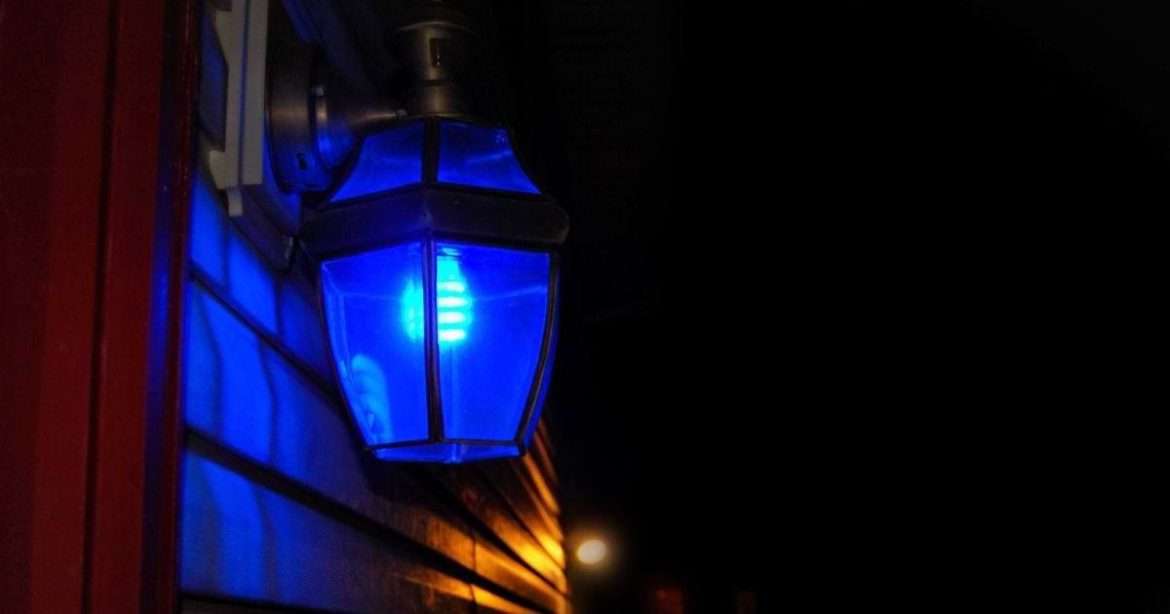Table of Contents
Blue porch lights have become a common sight in many neighborhoods worldwide, and while they may seem like nothing more than a decorative choice by homeowners. They carry hidden meanings that are worth exploring.
From showing support for law enforcement to raising awareness about autism, these blue lights can symbolize different causes depending on where they get placed. In this article, we’ll examine the secret meaning behind blue porch lights and how their significance can help us better understand our communities.
Supporting Law Enforcement

The Blue Light Movement is a grassroots effort to support law enforcement officers by displaying blue lights on homes, businesses, and public spaces. The movement originated in the United States as a response to increasing criticism of law enforcement practices and growing concerns about officer safety.
By shining a blue light, individuals and communities demonstrate their appreciation for the sacrifices made by police officers and their commitment to upholding the rule of law. Many see this movement as an important way to bridge gaps between law enforcement agencies and community members.
Proponents argue that supporting local police forces can help improve relationships between officers and citizens, reduce crime rates, and create safer neighborhoods overall.
At the same time, some criticize the movement as overly simplistic or even politicized. Many others find it empowering to feel part of something larger than themselves while showing appreciation for those who serve their communities.
Autism Awareness

Autism awareness is a cause that has become increasingly important in recent years. Autism, or autism spectrum disorder (ASD), is a complex developmental condition characterized by social and communication difficulties, sensory sensitivities, and repetitive behaviors. According to the Centers for Disease Control and Prevention (CDC), about 1 in 36 children have ASD. To raise awareness about this condition, many individuals and organizations worldwide participate in Autism Awareness Month every April.
Light It Up Blue, a global campaign created by the advocacy organization Autism Speaks, encourages people to wear blue or blue lights on houses on April 2nd and shine blue lights. It is used as a symbol of support for those with autism. This initiative has helped increase understanding of ASD among the general public and promote acceptance of neurodiversity.
Honouring the Brave

Blue Lights for Military Service Members are one of the essential purposes behind installing blue porch lights. The blue light has become a show of solidarity and appreciation for military service members who sacrifice their lives to serve and protect our country. This practice started after September 11, 2001, terrorist attacks in America. Hence, some refer to them as “blue stars” or “patriotic lights.”
Military families often install these blue porch lights to remind themselves about their loved ones serving abroad and provide support to them from home through this visible gesture. These lights also express gratitude towards those who have served before us and enhance community connection while acknowledging veterans’ efforts.
Overall, blue lights on houses have become an iconic way of honoring current and former military personnel who make immense sacrifices daily as they defend our great nation’s freedom.
Bringing Awareness Of Domestic Violence
Bringing awareness to domestic violence is crucial in combating this pervasive issue. One way people are doing this is through the “Turning Porches Blue” movement. By replacing their porch lights with blue ones, homeowners are showing support for victims of domestic violence. They are signaling that their home is safe for those experiencing abuse.
Moreover, this grassroots campaign has gained momentum worldwide, especially during Domestic Violence Awareness Month in October. The simple act of changing one’s porch light can start conversations and bring attention to the issue of domestic violence within communities. It also sends a powerful message to survivors that they are not alone and help is available.
Overall, Turning Porches Blue reminds us that we all have a role in ending domestic violence. Everyone can impact this critical issue by donating time or resources to organizations working towards prevention or simply learning more about the signs of abuse.
Mental Health Matters
Blue porch lights have recently gained recognition as a tool for suicide prevention. Mental Health Matters, a nonprofit organization in Michigan, launched the Blue Lights Campaign in 2013 to bring awareness to suicide and mental health struggles.
The idea behind this campaign is that blue lights serve as a reminder that some people struggle with suicidal thoughts. And it can encourage those individuals to seek help or support. This movement has gained traction throughout the United States and internationally and has become an effective way for communities to increase public discussion about mental health.
Many individuals may view blue porch lights as insignificantly decorative without considering their potential impact on mental well-being. However, these subtle signals hold immense power in starting essential conversations regarding healthcare resources, attitudes toward depression, and anxiety reduction strategies.
Ultimately, displaying these symbolic fixtures of blue lights on houses with care serves toward bridging psychosocial rifts within our neighborhoods and communities. It reminds them they do matter before something tragic happens.
Otherwise, lack of timely intervention measures at the earliest point possible condition-wise-motivated action can salvage lives from unnecessary loss today more than ever in the post-pandemic era. The era where uncertainties occur regularly upon us unprecedentedly like never before!
Supporting Essential Workers

As essential workers continue to put their lives on the line during the COVID-19 pandemic, communities have found new ways to support these heroes. One such method is by utilizing blue lights on houses, which serve as a visible symbol of gratitude and appreciation. This movement has spread across the world.
Neighborhoods are coming together to recognize the sacrifices made by healthcare professionals, first responders, grocery store employees, and other essential workers who keep our cities running. The power of blue porch lights lies not only in their symbolism but also in their ability to unify communities.
By choosing this simple gesture of support, individuals can connect with neighbors and communicate a shared gratitude towards front-line workers. The Blue Light Project.org even offers printable signs that people can display alongside their blue lights or share on social media using the hashtag #bluelightproject.
Supporting essential workers is more important than ever, so these small acts can make an enormous difference and go a long way toward sustaining frontline morale through difficult times.
Honouring Healthcare Heroes

During the coronavirus pandemic, healthcare workers have emerged as true heroes who tirelessly work to save lives and fight against the virus daily. Many people display blue lights on their porches to honor their hard work and sacrifice to show support and gratitude for these frontline workers. This simple gesture has gained traction across neighborhoods worldwide and is a visible reminder of our appreciation for those on the front lines.
By illuminating homes with blue porch lights, people are demonstrating unity in solidarity with healthcare professionals worldwide. This act uplifts those working under immense pressure and helps build a sense of community that reminds us that we’re all in this together. Moreover, it offers hope during these trying times by acknowledging essential workers’ efforts while they continue battling against COVID-19’s deadly impact daily.
How Project Blue Light began:
Project Blue Light originated in the United States in the early 2000s as a tribute to law enforcement officers who have died in the line of duty. It started with placing a single blue light in front of homes as a symbol of support and remembrance for fallen officers and their families. The idea gained traction quickly, spreading across communities and evolving into a nationwide movement to honor the sacrifices made by law enforcement personnel.
Other lights and their meaning:
Red Light: Often associated with safety and emergencies, a red light displayed outside a home may signal alertness or caution. It can also serve as a beacon for assistance or indicate a medical emergency.
Pink Light: A pink light may symbolize support for various causes, including breast cancer awareness and trans community rights, or as a welcoming gesture during specific events like weddings or celebrations.
Green Light: Green lights are commonly used to support veterans or symbolize environmental awareness. They may also represent hope, renewal, or solidarity with specific movements.
Blue Light: Apart from its association with Project Blue Light, a blue light displayed outside a house can signify various things depending on the context. It may represent peace, serenity, or support for law enforcement, healthcare workers, or autism awareness.
Purple Light: Purple lights are often used to raise awareness about domestic violence, Alzheimer’s disease, or epilepsy. They can also symbolize spirituality, honor, and respect for survivors or victims of various challenges.
Orange Porch Light: An orange porch light may indicate support for preventing gun violence, promoting awareness of multiple sclerosis, or providing a safety signal during Halloween. It can also symbolize energy, enthusiasm, or a warm welcome to visitors.
Conclusion
Blue porch lights have multiple symbolic meanings worldwide, representing support for law enforcement, autism awareness, honoring military service, combating domestic violence, advocating for mental health, and honoring healthcare heroes.
They unite communities, spark conversations, and remind us of the importance of support, gratitude, and compassion. These simple gestures significantly impact various societal issues, fostering unity and offering hope in challenging times.
